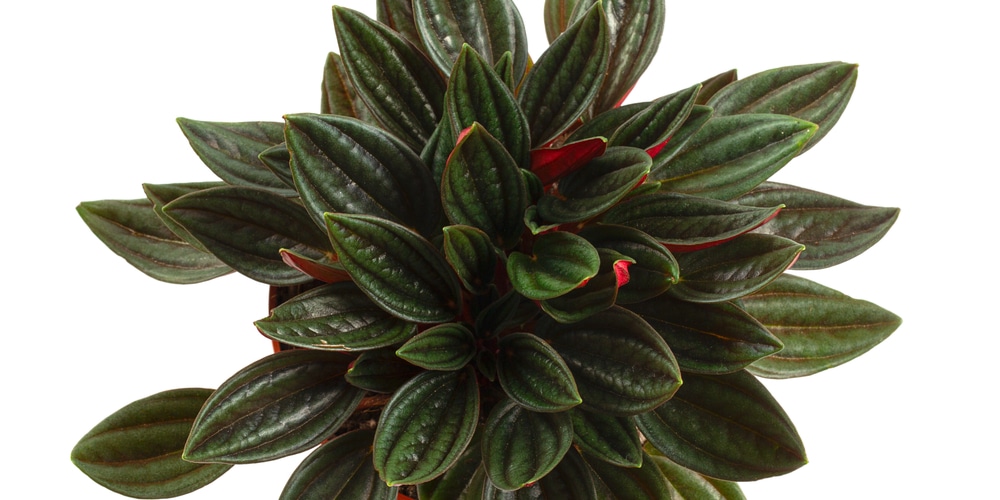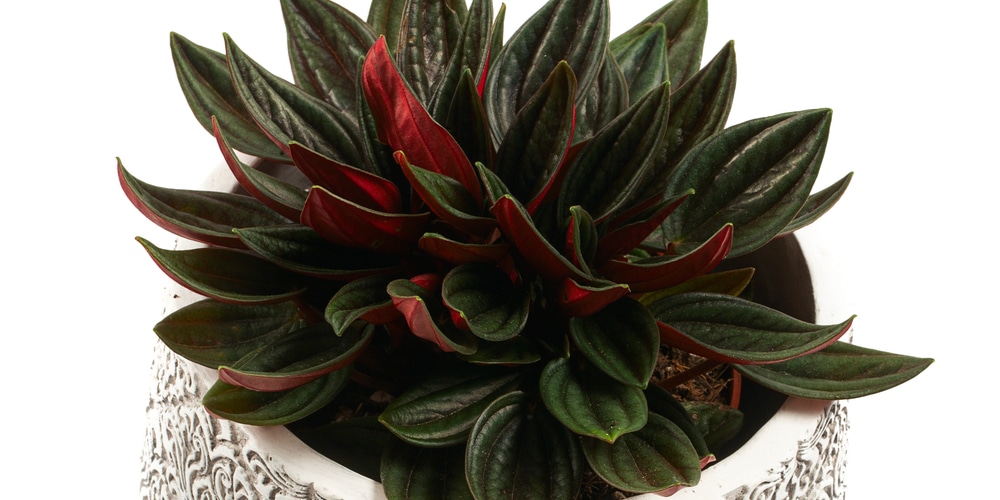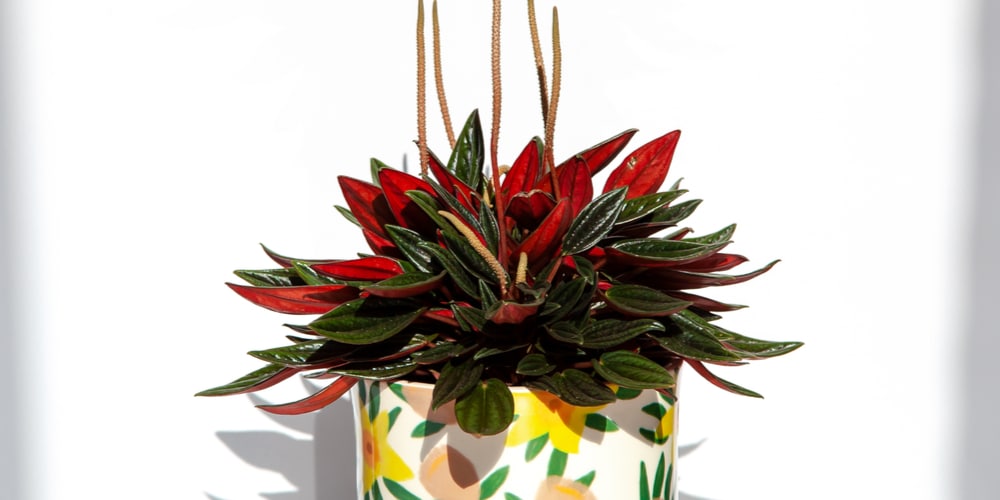Peperomia Rosso is one great houseplant. It not only beautifies a certain area inside your house but also purifies the indoor air. This peperomia plant can reduce the level of formaldehyde, which is a highly toxic gas, inside your house by 47%. Most of them are grown indoors, planted in small pots.
With its beautiful foliage and unique-looking flowers, Peperomia Rosso makes a great indoor decoration. The plant is perfect for desktops and dish gardens. Growing and caring for Peperomia Rosso is easy when you provide the right growing conditions. Let’s discuss further what specific growth requirements this peperomia plant requires in order to survive.
Peperomia Rosso Quick Facts

- Botanical Name: Peperomia Rosso
- Common Name: Emerald Ripple Pepper, Radiator Plant
- Plant Type: Perennial succulent
- Flower Color: Greenish-white, very small, scentless, and grows at the end of long reddish spikes
- Size When Mature: 8 inches
- Bloom Time: Summer, when days are longer
- Sun Requirements: Bright, indirect light
- USDA Hardiness Zone: 10a to 11b
- Soil PH Range: 6 to 6.6 pH
- Soil Type: Light, airy, and well-drained
- Water Needs: Medium
- Native Area: None, because it’s a cultivar and not a natural plant
What You Need to Know About Peperomia Rosso
Peperomia Rosso is a perennial succulent plant. Although most peperomia plants are native to Central and South America, Peperomia Rosso is an exception. It is not a natural plant but a cultivar plant. It is a cross between Peperomia Marmorata and Peperomia Metallica. Peperomia Rosso was grown in a laboratory and tested to survive in desert and cold weather conditions.
Despite this, Peperomia Rosso is also a tropical plant that shares the same characteristics and growth habits as the rest of the peperomia plants. It is low maintenance, so it is easy to grow, especially if you place it indoors. You don’t have to worry about getting poisoned, because Peperomia Rosso is not toxic to humans or animals.
Peperomia Rosso is known for its exceptional foliage and flowers. The plant only grows up to 10 inches in height and spread out to more than one foot. This small size is perfect for small pots, and the combination is a cute plant decor that you can put on your desk.
When the plant matures, the leaves and flowers appear more vibrant and beautiful. The foliage is dark-green in color, heart-shaped, and has a rubbery texture. The leaves can grow up to 1 to 2 inches long. The best part about the leaf is its reddish underside. Peperomia Rosso needs at least 12 hours of daylight in order to bloom during the growing season.
This is why the flowers of this peperomia plant appear in the summer because the days are longer during this season. The flower is small in size, scentless, and grows at the end of the spike. Yes! Spikes appear in between the leaves, adding more beauty to the succulent plant. The reddish spikes can measure up to 3 inches long.
How to Care for Peperomia Rosso
Always remember that Peperomia Rosso is a tropical plant. Although it’s only a cultivar, it is still a member of the peperomia family that thrives in warm and steamy environments. The plant is active during the summer months when it receives the most sunlight. It is easy to grow Peperomia Rosso, making it the best houseplant for beginners and those that don’t have a green thumb. Here are specific growing conditions that Peperomia Rosso likes.
Light
Peperomia Rosso needs bright, indirect light in order to grow. Or if you want, you can give it partial sun, like in the morning when the sunlight is still bearable. You can also use fluorescent lighting just to provide a bright light for indoor growing.
The plant cannot tolerate full, direct sun because it will scorch the leaves, especially the afternoon sun. A dark growing environment is also a no because it can slow down the growth of the plant. Place the pot where the plant can receive plenty of bright, indirect light. Remember that during the growing season, the plant needs at least 12 hours of light so you can witness its extraordinary flowers.
Water and Soil Needs
The plant requires balanced watering. This means overwatering and underwatering are both undesirable for Peperomia Rosso. The plant has fragile roots that will easily dry out in the absence of water. At the same time, overwatering will lead to rot, especially if the water comes into contact with the upper part of the plant.
This is why you only water the soil and the roots. Water the plant once the majority of the soil becomes dry. Water weekly in summer and water once every two months in winter. Peperomia Rosso is in constant need of moisture and nutrients, so the soil must be light, rich, well-drained, and airy. You can use a standard cactus mix, succulent potting mix, or orchid mix.
Temperature Requirements
If you live in USDA hardiness zones 10a to 11b, you can grow Peperomia Rosso in your garden or anywhere outside. The plant will survive the winter temperatures in your area, which can only go as low as 30 degrees F. Being a tropical plant, Peperomia Russo likes its habitat to be warm.
It cannot survive the winter in regions below zone 10, so might as well grow the plant indoors where you can easily set the room temperature. The plant thrives in temperature anywhere between 55 and 75 degrees F. The temperature should not be too high or too low.
Fertilizer
Newly repotted and baby plants don’t need fertilizer for their first six months. After that time, you can feed the plant with fertilizer during its active growing season. You can do this once or twice a month during the spring and summer. When autumn and winter come, when the plant is not actively growing, you can feed the plant just once a month.
When you use liquid fertilizer, make sure to not put it on the leaves, as this can damage the plant. The best fertilizer to use on a Peperomia Rosso plant is a balanced 20-20-20 fertilizer.
Common Diseases
Diseases can be avoided when you just provide the right growing conditions for the Peperomia Rosso plant. Overwatering, underwatering, and extreme temperatures are undesirable growing conditions that can weaken the plant.
This is the time when the plant is more susceptible to pests, including whiteflies, spider mites, and mealybugs. You can get rid of these harmful insects with the use of a horticultural oil spray. Always inspect the plant for infestations to avoid further spread.
Peperomia Rosso Propagation
You can propagate Peperomia Rosso by seeds or by stem and leaf cutting. Propagating by seeds is a slow and difficult process, so stem and leaf cuttings are always recommended. The best time to propagate Peperomia Rosso is during mid-spring. Use a sterilized and sharp knife to cut a 5 to 7-inch stem from a healthy plant. Remove the leaves from the lower part of the cutting. Plant the cutting in light, moist, and well-drained soil. After you plant the cutting, place the pot in a warm place that also receives bright, indirect light. After 3 to 4 weeks, the cut will start to sprout new growth.
How to Prune Peperomia Rosso
Peperomia Rosso is a slow-growing plant. It doesn’t need much pruning because it only grows a few leaves in months. Pruning is only done once a year, and the best time to do this is in early spring.
The purpose of pruning is to maintain the healthy and beautiful leaves of the succulent plant. You can also prune if you want to maintain the shape and pattern. Cut the leaves that are starting to decay and remove those that are not pleasing to the eyes.

